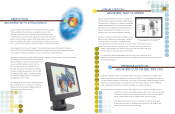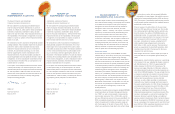Computer Associates 2000 Annual Report Download - page 11
Download and view the complete annual report
Please find page 11 of the 2000 Computer Associates annual report below. You can navigate through the pages in the report by either clicking on the pages listed below, or by using the keyword search tool below to find specific information within the annual report.
1918
purchase price attributed to IPR&D which was $150 million and
$645 million for Sterling and PLATINUM, respectively. Assets
were identified through on-site interviews with management and
a review of data provided by the Company and discussions with
the acquired companies’ management concerning the acquired
assets, technologies in development, costs necessary to com-
plete the IPR&D, historical financial performance, estimates of
future performance, market potential, and the assumptions
underlying these estimates.
The “Income Approach” was utilized for the valuation analysis of
IPR&D for both Sterling and PLATINUM. This approach focuses
on the income-producing capability of the asset and was
obtained through review of data provided by the Company and
the acquired companies and analysis of relevant market sizes,
growth factors, and expected trends in technology. The steps fol-
lowed in applying this approach included estimating the costs to
develop the purchased in-process technology into commercially
viable products, estimating the resulting net cash flows from
such projects, and discounting the net cash flows back to their
present values using a rate of return consistent with the relative
risk levels.
The ongoing development projects at Sterling at the time of the
purchase were comprised primarily of application development
and information management, business intelligence, network
management, and storage management tools and solutions.
The acquired projects included add-on features, tools and next-
generation versions of COOL, VISION, EUREKA, SAMS,™ and
SOLVE®product families. At the time of acquisition, it was esti-
mated that, on average, 68% of the development effort had
been completed and the remaining development effort would
take approximately 14 months to complete, with a cost of
approximately $9 million.
The ongoing development projects at PLATINUM at the time of
the purchase were comprised primarily of application develop-
ment, database, and enterprise management tools, and data
warehousing solutions. The acquired projects included add-on
features, tools and next-generation versions of DB2 Solutions,™
ProVision™ Security, AD
vantage
™ application development, end-
to-end data warehousing, and Internet infrastructure product
families. At the time of acquisition, it was estimated that, on
average, 68% of the development effort had been completed
and the remaining development effort would take approximately
12 months to complete, with a cost of approximately $41 million.
The resulting net cash flows from the Sterling and PLATINUM
projects were based on management’s estimates of product
revenues, cost of goods sold, operating expenses, R&D costs,
and income taxes from such projects. The revenue projections
used to value the IPR&D were based on estimates of relevant
market sizes and growth factors, expected trends in technol-
ogy, and the nature and expected timing of new product intro-
ductions by the Company and its competitors. The rate used
in discounting the net cash flows from the IPR&D approxi-
mated 20% for both Sterling and PLATINUM. These discount
rates, higher than that of the Company’s cost of capital, are
due to the uncertainties surrounding the successful develop-
ment of IPR&D. The efforts required to develop the in-process
technology of the acquired companies into commercially viable
products principally relate to the completion of planning,
designing, prototyping, and testing functions that are neces-
sary to establish that the software produced will meet its
design specifications, including technical performance,
features, and function requirements. The Company has
reviewed its projections of revenue and estimated costs of
completion and has compared these projections with results
through March 31, 2000. To date, in the aggregate, the pro-
jections have not varied materially from original projections.
If these projects do not continue to be successfully devel-
oped, the revenue and profitability of the Company may be
adversely affected in future periods. Additionally, the value of
other intangible assets acquired may become impaired.
Results will also be subject to uncertain market events and
risks that are beyond the Company’s control, such as trends
in technology, government regulations, market size and growth,
and product introduction by competitors. Management believes
that the assumptions used in the purchased IPR&D valuation
reasonably estimate the future benefits. There can be no
assurance that in future periods actual results will not deviate
from current estimates.
Year 2000 Issue
As of the date of this filing, the Company has not incurred any
significant business disruptions nor product interruptions as
a result of the Year 2000 date change. While no such occur-
rences have developed, Year 2000 issues may not become
apparent as of this date, and therefore there is no assurance
that the Company will not experience future disruptions.
The Company has designed and tested substantially all of its
recent product offerings to be Year 2000 compliant. These
products have met rigorous compliance criteria and have
undergone extensive review to detect any Year 2000 failures.
The Company has traditionally reported lower profit margins
in the first two quarters of each fiscal year than those experi-
enced in the third and fourth quarters. As part of the annual
budget process, management establishes higher discretionary
expense levels in relation to projected revenue for the first
half of the year. Historically, the Company’s combined third
and fourth quarter revenue has been greater than that of the
first half of the year, as these two quarters coincide with
clients’ calendar year budget periods and the culmination of
the Company’s annual sales plan. This historically higher sec-
ond half revenue has resulted in significantly higher profit mar-
gins since total expenses have not increased in proportion to
revenue. However, past financial performance should not be
considered to be a reliable indicator of future performance.
The Company’s products are designed to improve the produc-
tivity and efficiency of its clients’ information processing
resources. Accordingly, in a recessionary environment, the
Company’s products are often a reasonable economic alterna-
tive to customers faced with the prospect of incurring expendi-
tures to increase their existing information processing
resources. However, a general or regional slowdown in the
world economy could adversely affect the Company’s opera-
tions. Additionally, further deterioration of the exchange rate
of foreign currencies against the U.S. dollar may continue to
affect the Company’s ability to increase its revenue within
those markets.
As the Company grows, it is increasingly dependent upon
large dollar enterprise transactions with individual clients. The
size and magnitude of such transactions have increased over
time. There are no assurances that comparable transactions
will occur in subsequent periods.
The Company’s future operating results may also be affected
by a number of other factors, including but not limited to: a
significant percentage of the Company’s quarterly sales being
finalized in the last few days of the period making financial
forecasts especially difficult, which could create a substantial
risk of variances with the actual results; the continued risks of
potential litigation arising from the Year 2000 date change for
computer programs; the emergence of new competitive initia-
tives resulting from rapid technological advances; changes in
pricing in the market; the risks associated with new product
introductions as well as the uncertainty of marketplace
acceptance of these new or enhanced products from either
the Company or its competitors; risks associated with the
entry into new markets at lower profit margins, such as
professional services; the risks associated with integrating
newly acquired businesses and technologies; delays in prod-
uct delivery; reliance on mainframe capacity growth; the ability
to recruit and retain qualified personnel; business conditions
in the distributed and mainframe software and hardware mar-
kets; the strength of the Company’s distribution channels;
uncertainty and volatility associated with Internet and
eBusiness related activities; the ability to update the
Company’s product offerings to conform with new governmental
rules; use of software patent rights to attempt to limit compe-
tition; fluctuations in foreign currency exchange rates and
interest rates; the volatility of the international marketplace;
uncertainties relative to global economic conditions; the
Company’s reliance on a single family of products for a mate-
rial portion of its sales; the effect of new accounting pro-
nouncements and interpretations on the Company’s revenue
recognition practices; the Company’s ability to manage fixed
and variable expense growth relative to revenue growth; and
other risks described in the Company’s filings with the
Securities and Exchange Commission.
With the acquisition of Sterling on March 31, 2000, and a
subsequent worldwide sales reorganization in April 2000,
there can be no assurances that the distractions and uncer-
tainties caused by these events will not have a negative effect
on the Company’s revenue and net income during fiscal year
2001.
In-Process Research and Development
In the fourth quarter of fiscal year 2000, the Company acquired
Sterling in a stock-for-stock exchange valued at approximately
$4.1 billion. In the first quarter of fiscal year 2000, the Company
acquired PLATINUM for approximately $4.3 billion in cash and
assumed liabilities. There were no acquisitions involving acquired
in-process research and development (“IPR&D”) charges in fiscal
year 1999. See Note 2 of Notes to Consolidated Financial
Statements for additional information concerning acquisitions.
Acquired IPR&D charges relate to acquisitions of software com-
panies accounted for under the purchase method, in which a
portion of the purchase price is allocated to acquired in-process
technology and is expensed immediately, since the technological
feasibility of the research and development projects have not yet
been achieved and are believed to have no alternative future
use. Independent valuations of Sterling and PLATINUM were per-
formed and used as an aid in determining the fair value of the
identifiable intangible assets and in allocating the purchase price
among the acquired assets, including the portion of the
























